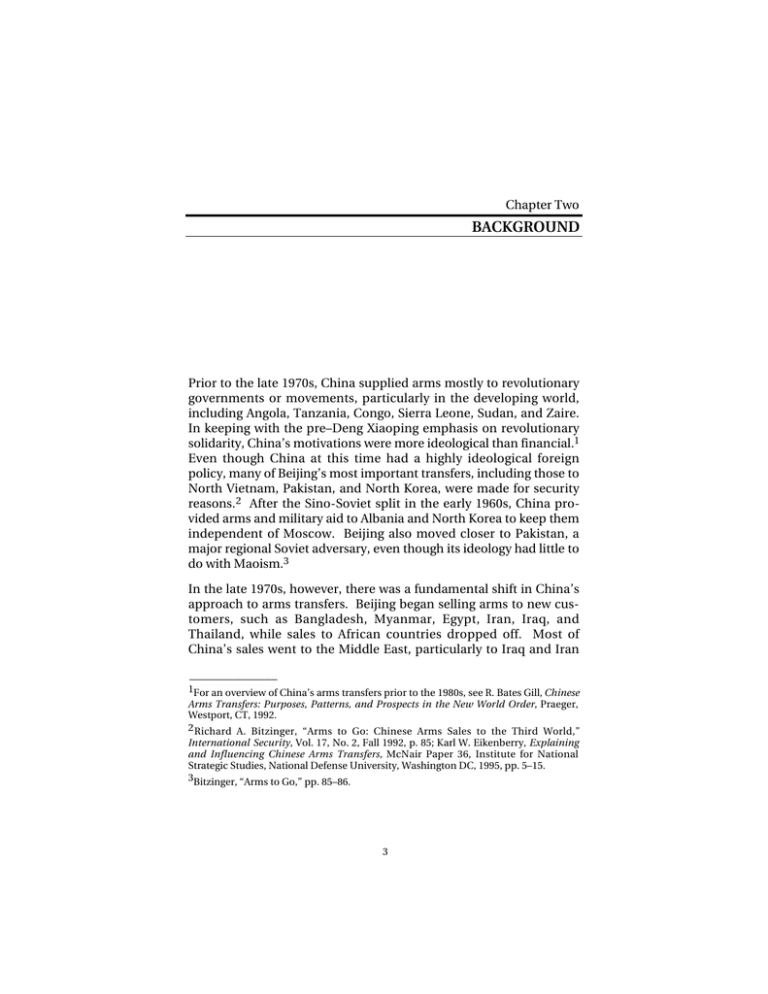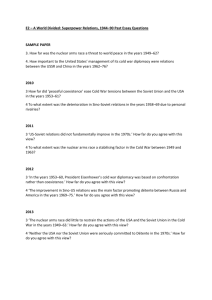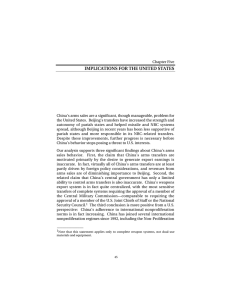BACKGROUND
advertisement

Chapter Two BACKGROUND Prior to the late 1970s, China supplied arms mostly to revolutionary governments or movements, particularly in the developing world, including Angola, Tanzania, Congo, Sierra Leone, Sudan, and Zaire. In keeping with the pre–Deng Xiaoping emphasis on revolutionary solidarity, China’s motivations were more ideological than financial.1 Even though China at this time had a highly ideological foreign policy, many of Beijing’s most important transfers, including those to North Vietnam, Pakistan, and North Korea, were made for security reasons. 2 After the Sino-Soviet split in the early 1960s, China provided arms and military aid to Albania and North Korea to keep them independent of Moscow. Beijing also moved closer to Pakistan, a major regional Soviet adversary, even though its ideology had little to do with Maoism.3 In the late 1970s, however, there was a fundamental shift in China’s approach to arms transfers. Beijing began selling arms to new customers, such as Bangladesh, Myanmar, Egypt, Iran, Iraq, and Thailand, while sales to African countries dropped off. Most of China’s sales went to the Middle East, particularly to Iraq and Iran ______________ 1For an overview of China’s arms transfers prior to the 1980s, see R. Bates Gill, Chinese Arms Transfers: Purposes, Patterns, and Prospects in the New World Order, Praeger, Westport, CT, 1992. 2 Richard A. Bitzinger, “Arms to Go: Chinese Arms Sales to the Third World,” International Security, Vol. 17, No. 2, Fall 1992, p. 85; Karl W. Eikenberry, Explaining and Influencing Chinese Arms Transfers, McNair Paper 36, Institute for National Strategic Studies, National Defense University, Washington DC, 1995, pp. 5–15. 3Bitzinger, “Arms to Go,” pp. 85–86. 3 4 China’s Arms Sales: Motivations and Implications during the bitter war these two countries fought from 1980 to 1988.4 By the mid-1980s, China was the world’s fourth largest arms supplier (after the Soviet Union, United States, and France).5 Most of the weapons China has transferred have been relatively lowtech, consisting primarily of Chinese copies of 1950s and 1960s Soviet systems (although the Chinese products have been said to be of higher quality than the original Soviet equipment).6 The Type-59 tank, for example, is the Chinese version of the Soviet T-54, while the F-6 and F-7 fighter jets are Chinese versions of the MiG-19 and MiG21. Even the notorious HY-2 “Silkworm” antishipping missile is simply an improved version of the Soviet 1950s-era P-15 “Styx” system. These weapons are generally less capable than systems currently sold by Western countries or Russia and have often been used to equip second-line units or to pad out the military inventories of the recipient nations. The systems transferred have not represented a serious threat to stability or security.7 A list of China’s transfers in the 1980s and 1990s is presented in the appendix. Beginning in the late 1980s, however, China began to make arms transfers that were much more worrisome. In 1987, China sold nuclear-capable intermediate-range ballistic missiles to Saudi Arabia.8 In the same year, Iran used Chinese-made Silkworm missiles to disrupt shipping in the Persian Gulf. China’s refusal to curtail or even admit to these sales prompted the United States to delay liberalization of technology sales to China, the first instance of a U.S. sanction on China since the normalization of relations in 1978.9 At about the ______________ 4 Bitzinger, “Arms to Go,” p. 87. Iran and Iraq accounted for 57 percent of Chinese arms sales during the 1980s. 5Stockholm International Peace Research Institute, SIPRI Yearbook 1992: Armaments, Disarmament, and International Security, Oxford University Press, Oxford, New York, 1992, p. 272. 6“Birth of an Arms Salesman,” The Economist, November 17, 1984, p. 40. 7 Francois Godemont, “China’s Arms Sales,” in Gerald Segal and Richard H. Yang (eds.), Chinese Economic Reform: The Impact on Security, Routledge, London and New York, 1996, p. 98. 8 Shirley A. Kan, Chinese Proliferation of Weapons of Mass Destruction: Background and Analysis, CRS Report for Congress, Congressional Research Service, Washington DC, September 13, 1996, p. 14. 9Nayan Chanda, “Technology Cocooned,” Far Eastern Economic Review, November 5, 1987, p. 34. Background 5 same time, China reportedly came to an agreement with Syria to sell it M-9 short-range ballistic missiles (SRBMs). This sale was apparently never consummated as a result of U.S. and Israeli pressure, but China did transfer components of the M-11 SRBM to Pakistan in 1991–1992 and has provided technical assistance to the ballistic missile programs in both Pakistan and Iran. China also subsequently transferred more antishipping cruise missiles, in this case the more advanced C-801 and C-802, despite U.S. protests. Even more alarming was China’s assistance to the nuclear programs of several countries. China reportedly provided significant assistance to Pakistan’s clandestine nuclear weapons program in the 1980s, including supplying it with a nuclear weapon design and fissile material. Beijing continued to provide further nuclear assistance in the 1990s, although perhaps no longer directly to Pakistan’s nuclear weapons program.10 China also assisted the nuclear programs of Iran and Algeria. Although this assistance was ostensibly for research and therefore was consistent with the terms of the NonProliferation Treaty (NPT) (which China did not sign until 1992), both Iran and Algeria had large undeveloped energy reserves and appeared to lack a legitimate need for nuclear power, leading to suspicions that their true purpose was to develop the expertise needed for producing nuclear weapons. In addition to its nuclear assistance to Iran, China has been accused of contributing to Iran’s chemical weapons program. The nature of the recipients of many Chinese arms transfers is cause for concern. Customers have included Iran, Iraq, North Korea, and Myanmar, which are among the world’s leading pariah states, and Pakistan, which has refused to join the nuclear nonproliferation regime and recently tested several nuclear weapons. China’s arms transfers and their recipients have caused concern throughout the world and highlighted the question of whether China wishes to be a responsible member of the international community. In sum, China’s arms transfer record is troubling. China has transferred equipment and technology related to missiles and nuclear and ______________ 10Kan, Chinese Proliferation of Weapons of Mass Destruction, pp. 27–31. 6 China’s Arms Sales: Motivations and Implications chemical weapons, and its customers have included states that other nations are unwilling to sell to. Understanding the motivations for these sales and ways to limit them is an important task.






